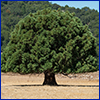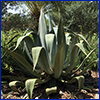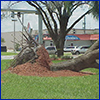The Neighborhood Gardener – June

Happy Gardening!
Much of Florida has seen plenty of rain in the last few days, and you can thank us—this month's Neighborhood Gardener focuses on Florida's drought (as of June 6, much of central and north-central Florida is still considered to be in moderate or extreme drought, even with the rain).
Ten Ways to Save Water
 There are many ways to save water in your landscape; we walk you through the basics. From choosing the right plant for the right place to calibrating your irrigation system and everything in between, we give you ten ways to save water in your landscape. More
There are many ways to save water in your landscape; we walk you through the basics. From choosing the right plant for the right place to calibrating your irrigation system and everything in between, we give you ten ways to save water in your landscape. More
Tree Care During a Drought
 During a drought it can be easy to spend your time worrying about your lawn and smaller landscape plants—and forget about your mature trees. But an extended drought can actually cause decline and even death in both young and old trees. Drought damage occurs first in the middle of the tree canopy, often far out of sight, so the best way to protect your trees during a drought is to water them before they show signs of drought stress.
More
During a drought it can be easy to spend your time worrying about your lawn and smaller landscape plants—and forget about your mature trees. But an extended drought can actually cause decline and even death in both young and old trees. Drought damage occurs first in the middle of the tree canopy, often far out of sight, so the best way to protect your trees during a drought is to water them before they show signs of drought stress.
More
Wendy's Wanderings
 It was with best intentions that we pulled together the "drought edition" of the Neighborhood Gardener newsletter for June 2017. The drought had reached critical levels in a couple areas of Florida and the rest of the state just plain needed the rain. Wildfires were popping up across the peninsula and lawns were turning a crispy shade of brown. Educating our readers on drought-proofing their landscapes seemed like a great idea. The best laid plans of mice and men... More
It was with best intentions that we pulled together the "drought edition" of the Neighborhood Gardener newsletter for June 2017. The drought had reached critical levels in a couple areas of Florida and the rest of the state just plain needed the rain. Wildfires were popping up across the peninsula and lawns were turning a crispy shade of brown. Educating our readers on drought-proofing their landscapes seemed like a great idea. The best laid plans of mice and men... More
Plant of the Month: Century Plant
 With bold, succulent leaves that can be up to 6 feet long and a towering flower spike that can reach 20 feet, the century plant is certainly a show-stopping landscape addition. "Century plant" is a misleading name, though. This drought-tolerant plant doesn't actually take 100 years to mature or flower; it's more between 8 to 30 years. While century plant (Agave americana) and the equally eye-catching variegated variety are lovely to look at in the landscape, they are both sharply spined and thus should be planted well away from where people or pets may run afoul of the leaves. Or you can try the spineless, smaller Agave attenuata, aptly named spineless century plant. More
With bold, succulent leaves that can be up to 6 feet long and a towering flower spike that can reach 20 feet, the century plant is certainly a show-stopping landscape addition. "Century plant" is a misleading name, though. This drought-tolerant plant doesn't actually take 100 years to mature or flower; it's more between 8 to 30 years. While century plant (Agave americana) and the equally eye-catching variegated variety are lovely to look at in the landscape, they are both sharply spined and thus should be planted well away from where people or pets may run afoul of the leaves. Or you can try the spineless, smaller Agave attenuata, aptly named spineless century plant. More
Assessing Your Home's Wildfire Risk
 Two of the factors that contribute to the wildfire risk to your home are how the land is used or developed in your area, coupled with the kind of vegetation surrounding your dwelling. There are a few immediate actions you can take to protect your home, including clearing debris from your roof and structures, and planting low-flammability plants. You can also take a look around your home and determine what risk factors exist on your specific site. More
Two of the factors that contribute to the wildfire risk to your home are how the land is used or developed in your area, coupled with the kind of vegetation surrounding your dwelling. There are a few immediate actions you can take to protect your home, including clearing debris from your roof and structures, and planting low-flammability plants. You can also take a look around your home and determine what risk factors exist on your specific site. More
A Better Lawn on Less Water
 An automatic irrigation system can be a great tool for keeping your landscape watered, but it's important to use it correctly. Your irrigation system should never operate on a fixed schedule, the controller should be set to the "off" setting and you should be only watering as needed. When does your lawn need to be watered? When 30 or 50 percent of your lawn shows at least one of the three signs of wilt—folding leaf blades, blue-gray color, or footprints remaining visible in the grass—it's time to activate your irrigation system.
More
An automatic irrigation system can be a great tool for keeping your landscape watered, but it's important to use it correctly. Your irrigation system should never operate on a fixed schedule, the controller should be set to the "off" setting and you should be only watering as needed. When does your lawn need to be watered? When 30 or 50 percent of your lawn shows at least one of the three signs of wilt—folding leaf blades, blue-gray color, or footprints remaining visible in the grass—it's time to activate your irrigation system.
More
June in Your Garden
 With the official start of hurricane season beginning in June, this is a great time to take a look at your landscape and be sure you are hurricane ready before a storm is headed your way. Tree pruning and maintenance are an especially important part of preparing for a hurricane. Train young trees so they develop a sturdy, well-spaced framework of healthy branches along a dominant trunk. For trees larger than about 15 feet tall, hire a certified arborist to prune your trees before the hurricane season.
With the official start of hurricane season beginning in June, this is a great time to take a look at your landscape and be sure you are hurricane ready before a storm is headed your way. Tree pruning and maintenance are an especially important part of preparing for a hurricane. Train young trees so they develop a sturdy, well-spaced framework of healthy branches along a dominant trunk. For trees larger than about 15 feet tall, hire a certified arborist to prune your trees before the hurricane season.
For more month-by-month gardening tips, check out the Florida Gardening Calendar. Three different editions of the calendar provide specific tips for each of Florida's gardening regions—North, Central, and South.
Providing Water for Wildlife
 Surface water sources such as puddles, raindrops on leaves, and dew on grass provide much of the water used by wildlife. Animals also get water from the foods they eat. But clean, fresh water that’s accessible to wildlife can often be hard to find, especially during a drought. You can do your part to help sustain thirsty creatures in your backyard by maintaining birdbaths, butterfly watering stations, and even small ponds and fountains. More
Surface water sources such as puddles, raindrops on leaves, and dew on grass provide much of the water used by wildlife. Animals also get water from the foods they eat. But clean, fresh water that’s accessible to wildlife can often be hard to find, especially during a drought. You can do your part to help sustain thirsty creatures in your backyard by maintaining birdbaths, butterfly watering stations, and even small ponds and fountains. More
What's Going On?
If your Master Gardener program or Extension office is having an event, be sure to share it with us.

